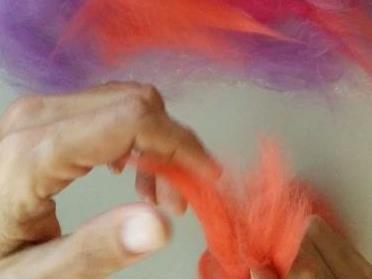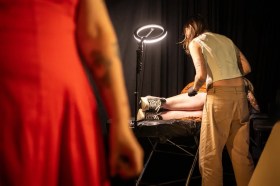Image: Helen Crawford via Country Arts
We’re all aware of mental health. We have come a long way to reduce its stigma. But it’s not an area that is easy to work in, especially when you are not equipped.One in five Australians in the past year suffered from a mental health issue – and that is just the statistics that are collected.
It is harder for people in regional areas to access mental health services.As regional arts workers we work with community in prevention and early intervention to keep people out of hospital, connected to their community and connected to services that support their recovery. This is especially important in communities where mental health services are few and dwindling.
We recognise that we are not social workers, or counsellors. When art stirs up emotions we may need access to a professional counsellor to explore the issue and take it to the next step. With us, it is about art and art making and that in itself is the start of the conversation. On the surface we’re doing art but dig deeper and you see that it’s about giving people life skills, confidence, links to support services. We are here to help people gain life skills. But we need to be equipped to know how to do so.
In my position at Country Arts SA, I was driven to provide a user-friendly resource that could be the starting point of discussion for an artist and a mental health worker when planning a project.
Often throughout my career in the arts and in education working within the realms of mental health, I’ve come across people who mean well, but ultimately might actually be having a detrimental effect on the participant. This is because they don’t have the resources they need to help others.
I’ve been working in arts and mental health for many years now and what I have noticed is a lack of resources in this sector. There are resources and training in Art Therapy and a recent framework developed by the Federal Government for Arts and Health, however when researching to produce guidelines for this sector, I noticed that people working in Community Arts and Mental Health were searching for resources for planning and managing projects.
Prior to working in arts and mental health, I was a secondary school art teacher in special education. When I walked into a class room I needed to be a registered teacher, have first aid training, police checks, safe work practice with children, OHS training with art materials, etc. It’s a long list. Yet there was no such list to equip artists and mental health workers with the necessary tools and confidence when working with participants in community arts and mental health.
It’s crucial for people’s wellbeing that their health is not analysed through their art. Just because you’re using dark colours in a visual art piece for example, it doesn’t mean you’re going through an especially sombre period in your life. It’s not that simple. We’re not here to analyse somebody’s mental health through their art but to support their creative process so they experience the benefits of art engagement.
We want to make sure that future projects are held in a nurturing space where the participant’s needs come first and they are encouraged to take their own artistic risks and be curious without any judgement or criticism. I think this is a crucial element in supporting the participant’s art experience in a positive way.
Bringing It All Together – Guidelines for Arts and Mental Health Projects was established to help arts and mental health workers support the participant’s journey of recovery through creative activity.
The guidelines we developed, in conjunction with a peer-assessed panel and community artist Helen Crawford who ran the associated workshops, address a desire from stakeholders to be working on the same page when planning and working in this specialised area. Individuals and organisations working in this field are genuinely hungry for support resources to assist with project development and implementation.
To move forward with prevention and early intervention strategies we need State and Federal Governments to work together and service providers to be accountable, to measure and report on how they are going. The current health system is difficult to navigate for people experiencing mental illness and we are committed to working at the coal face of the community to find better outcomes for the participants by listening to what is needed. Our program evaluates how successful our aims and objectives are with our community art projects and reports capture statistics and feedback for planning future successful projects.
I hope this resource is the starting point for a conversation.
A long standing partnership between Country Health SA and Country Arts SA has enabled Country Arts SA produced Bringing It All Together – Guidelines for Arts and Mental Health Projects to be developed to better equip artists and mental health workers in this specific field.





